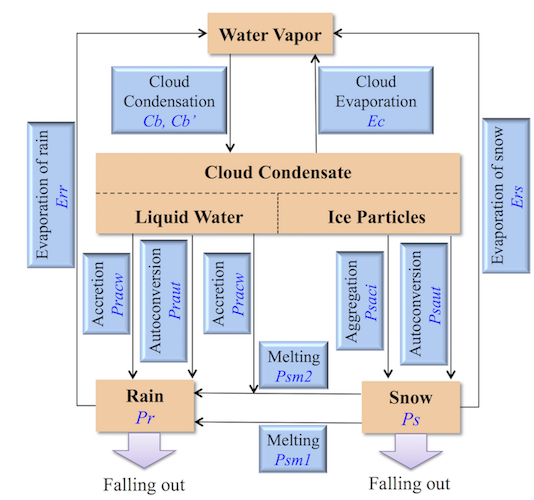This subroutine computes the conversion from condensation to precipitation (snow or rain) or evaporation of rain. More...
This subroutine computes the conversion from condensation to precipitation (snow or rain) or evaporation of rain.
The parameterization of precipitation is required in order to remove water from the atmosphere and transport it to the ground. In the scheme discussed here, simplifications in the precipitation parameterization are used due to computational limitations required by operational NWP models. First, consideration of particle size and shape can be avoided by using the bulk parameterization method introduced by Kessler (1969) [32]. Second, only two types of precipitation, rain and snow, are considered in this scheme. Third, only the most important microphysical processes associated with the formation of rain and snow are included. Figure 2 presents the microphysical processes considered in the precipitation parameterization.

"Figure 2: Microphysical processes simulated in the precipitation scheme " width=5cm Basically, there are four types of microphysical processes considered here:
The following two equations can be used to calculate the precipitation rates of rain and snow at each module level:
\[ P_{r}(\eta)=\frac{p_{s}-p_{t}}{g\eta_{s}}\int_{\eta}^{\eta_{t}}(P_{raut}+P_{racw}+P_{sacw}+P_{sm1}+P_{sm2}-E_{rr})d\eta \]
and
\[ P_{s}(\eta)=\frac{p_{s}-p_{t}}{g\eta_{s}}\int_{\eta}^{\eta_{t}}(P_{saut}+P_{saci}-P_{sm1}-P_{sm2}-E_{rs})d\eta \]
where \(p_{s}\) and \(p_{t}\) are the surface pressure and the pressure at the top of model domain, respectively, and \(g\) is gravity. The implementation of the precipitation scheme also includes a simplified procedure of computing \(P_{r}\) and \(P_{s}\) (Zhao and Carr(1997) [58]).

|
| subroutine | precpd (im, ix, km, dt, del, prsl, q, cwm, t, rn, sr , rainp, u00k, psautco, prautco, evpco, wminco , lprnt, jpr) |
| subroutine precpd | ( | integer | im, |
| integer | ix, | ||
| integer | km, | ||
| real (kind=kind_phys) | dt, | ||
| real (kind=kind_phys), dimension(ix,km) | del, | ||
| real (kind=kind_phys), dimension(ix,km) | prsl, | ||
| real (kind=kind_phys), dimension(ix,km) | q, | ||
| real (kind=kind_phys), dimension(ix,km) | cwm, | ||
| real (kind=kind_phys), dimension(ix,km) | t, | ||
| real (kind=kind_phys), dimension(im) | rn, | ||
| real (kind=kind_phys), dimension(im) | sr, | ||
| real (kind=kind_phys), dimension(im,km) | rainp, | ||
| real (kind=kind_phys), dimension(im,km) | u00k, | ||
| real (kind=kind_phys), dimension(im) | psautco, | ||
| real (kind=kind_phys), dimension(im) | prautco, | ||
| real (kind=kind_phys) | evpco, | ||
| real (kind=kind_phys), dimension(2) | wminco, | ||
| logical | lprnt, | ||
| integer | jpr | ||
| ) |
| [in] | im | horizontal number of used pts |
| [in] | ix | horizontal dimension |
| [in] | km | vertical layer dimension |
| [in] | dt | time step in seconds |
| [in] | del | pressure layer thickness (bottom to top) |
| [in] | prsl | pressure values for model layers (bottom to top) |
| [in,out] | q | specific humidity (updated in the code) |
| [in,out] | cwm | condensate mixing ratio (updated in the code) |
| [in,out] | t | temperature (updated in the code) |
| [out] | rn | precipitation over one time-step dt (m/dt) |
| [out] | sr | "snow ratio", ratio of snow to total precipitation |
| [out] | rainp | rainwater path |
| [in] | u00k | the critical value of relative humidity for large-scale condensation |
| [in] | psautco | auto conversion coeff from ice to snow = 4.0E-4; defined in module_MP_GFS.F90 |
| [in] | prautco | auto conversion coeff from cloud to rain = 1.0E-4; defined in module_MP_GFS.F90 |
| [in] | evpco | coeff for evaporation of largescale rain = 2.0E-5; defined in module_MP_GFS.F90 |
| [in] | wminco | coeff for water and ice minimum threshold to conversion from condensate to precipitation = \1.0E-5, 1.0E-5\; defined in module_MP_GFS.F90 |
| [in] | lprnt | logical print flag |
| [in] | jpr | check print point for debugging |
\[ cwm > \min (wmin, wmini) \]
where the cloud water and ice conversion threshold:\[ wmin=wminco(1)\times prsl\times 10^{-5} \]
\[ wmini=wminco(2)\times prsl\times 10^{-5} \]
\[ P_{saut}=a_{1}(cwm-wmini) \]
Since snow production in this process is caused by the increase in size of cloud ice particles due to depositional growth and aggregation of small ice particles, \(P_{saut}\) is a function of temperature as determined by coefficient \(a_{1}\), given by\[ a_{1}=psautco \times dt \times exp\left[ 0.025\left(T-273.15\right)\right] \]
\[ P_{saci}=C_{s}cwm P_{s} \]
where \(P_{s}\) is the precipitation rate of snow. The collection coefficient \(C_{s}\) is a function of temperature since the open structures of ice crystals at relative warm temperatures are more likely to stick, given a collision, than crystals of other shapes (Rogers 1979 [47]). Above the freezing level, \(C_{s}\) is expressed by\[ C_{s}=c_{1}exp\left[ 0.025\left(T-273.15\right)\right] \]
where \(c_{1}=1.25\times 10^{-3} m^{2}kg^{-1}s^{-1}\) are used. \(C_{s}\) is set to zero below the freezing level.\[ P_{raut}=(prautco \times dt )\times (cwm-wmin)\left\{1-exp[-(\frac{cwm-wmin}{m_{r}b})^{2}]\right\} \]
where \(m_{r}\) is \(3.0\times 10^{-4}\).\[ P_{saci}=C_{s}cwmP_{r} \]
where \(C_{r}=5.0\times10^{-4}m^{2}kg^{-1}s{-1}\) is the collection coeffiecient. Note that this process is not included in current operational physcics.\[ E_{rr}= evpco \times (u-f)(P_{r})^{\beta} \]
where \(u\) is u00k, \(f\) is the relative humidity. \(\beta = 0.5\) are empirical parameter.\[ E_{rs}=[C_{rs1}+C_{rs2}(T-273.15)](\frac{u-f}{u})P_{s} \]
where \(C_{rs1}=5\times 10^{-6}m^{2}kg^{-1}s^{-1}\) and \(C_{rs2}=6.67\times 10^{-10}m^{2}kg^{-1}K^{-1}s^{-1}\). The evaporation of melting snow below the freezing level is ignored in this scheme because of the difficulty in the latent heat treatment since the surface of a melting snowflake is usually covered by a thin layer of liquid water.\[ P_{sm1}=C_{sm}(T-273.15)^{2}P_{s} \]
where \(C_{sm}=5\times 10^{-8}m^{2}kg^{-1}K^{-2}s^{-1}\) cause the falling snow to melt almost completely before it reaches the \(T=278.15 K\) level.\[ P_{sacw}=C_{r}cwmP_{s} \]
where \(C_{r}\) is the collection coefficient, \(C_{r}=5.0\times 10^{-4}m^{2}kg^{-1}s^{-1}\) . The melting rate of snow then can be computed from\[ P_{sm2}=C_{ws}P_{sacw} \]
where \(C_{ws}=0.025\).\[ t=t-\frac{L}{C_{p}}(E_{rr}+E_{rs}+P_{sm1})\times dt \]
\[ q=q+(E_{rr}+E_{rs})\times dt \]
\[ rn= (P_{r}(\eta_{sfc})+P_{s}(\eta_{sfc}))/10^3 \]
\[ sr=\frac{P_{s}(\eta_{sfc})}{P_{s}(\eta_{sfc})+P_{r}(\eta_{sfc})} \]
Definition at line 81 of file precpd.f.
References physcons::con_cp, physcons::con_g, physcons::con_hfus, physcons::con_hvap, and physcons::con_ttp.
Referenced by gbphys().
